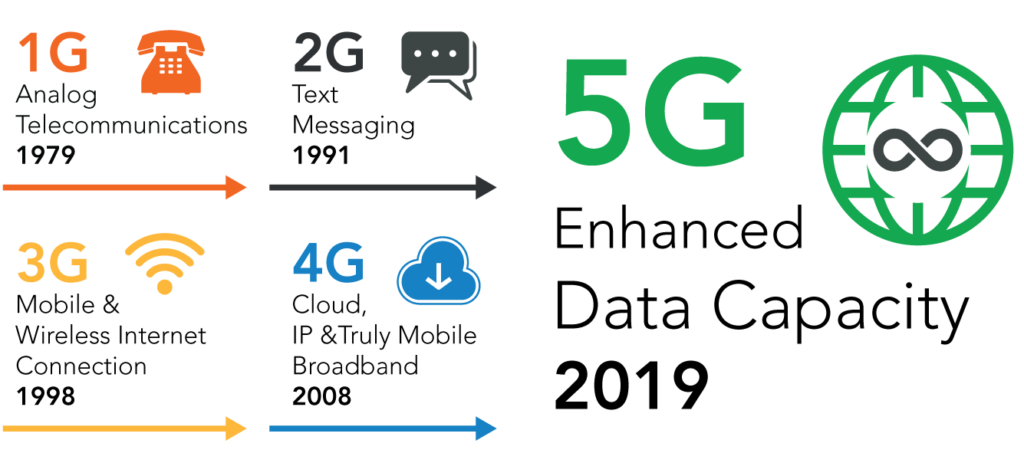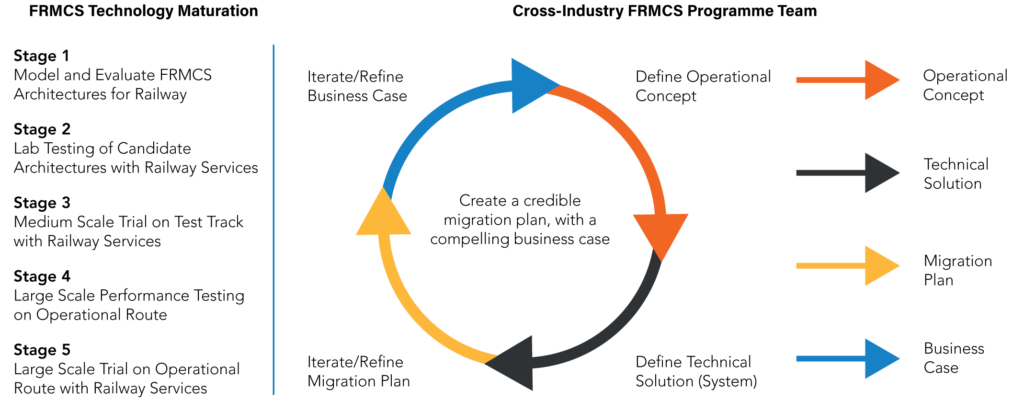The rail industry faces many challenges, with one being the migration of the Global System for Mobile Communications-Railway (GSM-R) to the Future Railway Mobile Communications System (FRMCS). GSM-R is the train radio system which provides operational communications between drivers and signallers, and facilities including Railway Emergency Group Call (REC) to alert an emergency situation.
GSM-R is based on 2G GSM technology and is fast becoming obsolete. FRMCS is the new train radio system specified by the International Union of Railways (UIC), and is the subject of a paper by Thales, published by the IRSE, explaining what is involved with the migration from GSM-R. The paper was written by Sam Daw, David Grace, and David Taylor of Thales, with the assistance of Mark Maclean of Telent, Luke Coomber of Mott Macdonald, and Amit Seth of Firstco.
FRMCS is based on 5G and will provide reliable, low-latency, mission-critical communications for routine and emergency requirements. It will also provide for applications such as massive and critical machine type communications and the Internet of Things (IoT).
GSM-R was initially ‘voice only’ with ETCS data provided later, but only in a basic form. While this may be sufficient for some ETCS operation, problems are likely with a high density of GSM-R users in a limited area, for example at busy railway stations. GSM-R was also an ‘add on’ to GSM, but with FRMCS a lot of the railways requirements are already built into the 5G architecture.
Even with its obsolescence, GSM-R limitations compared to modern communications do not support a truly digital mobile solution for applications such as national ETCS. The industry is also starting to suffer from skills gaps, with fewer engineers available with the right skills to support GSM-R.
Thales says there are a number of ‘gains’ associated with an early migration to FRMCS and that planning must start now. FRMCS will enable a greater ability to exploit railway system data to create a more intelligent and improved ‘data-driven’ railway, increasing operational safety, performance, and efficiency.
The challenges
The specifications for FRMCS are being established by standards bodies including the European Telecommunications Standards Institute (ETSI), the 3G Partnership Programme (3GPP), and the International Telecommunication Union (ITU). The UIC is also collaborating with a number of railway stakeholders including the European Rail Agency (ERA), and the Association of the European Rail Supply Industry (UNIFE) UNITEL Committee has been established to support and actively contribute to the technical standards.
Version V1 of the Functional Requirements Specifications (FRS) and System Requirements Specifications (SRS) were published in June 2023 and version V2 specifications are likely to be published by June 2024. With funding from the European Union’s Horizon 2020 innovation and research programme, 5GRail is targeting the first FRMCS demonstrator for 2025.
The UIC has the objective of FRMCS solutions being commercially available from the end of 2026. There will be the opportunity to define a Radio Access Network (ORAN)-based solution from the 5G mobile telecoms manufacturers or to define an FRMCS ORAN. ORAN offers the potential for enhanced resiliency, scalability, faster innovation, and improved cyber security at lower costs.

Spectrum
The European Conference of Postal and Telecommunications Administrations (CEPT) defines the radio frequency spectrum allocation in Europe, with Ofcom looking after the UK. CEPT has allocated the paired frequency bands 874.4-880.0 MHz and 919.4-925.0 MHz, and the unpaired frequency band 1900-1910 MHz for GSM-R and migration to FRMCS.
Currently, in the UK, 874.4-880 MHz and 919.4-925.0 MHz are allocated to rail use, but not 1900-1910 MHz. Ofcom is consulting on the optimal use of 1900-1920 MHz and says that EE’s current 4G licence to provide the Home Office’s Emergency Services Network (ESN) Gateway using this frequency band may not be optimal, with 1915-1920 MHz more suitable for the ESN Gateway.
Ofcom’s consultation drew 14 responses, including from Network Rail which re-emphasised the case for the allocation of 1900-1910 MHz for rail and FRMCS, fully aligning the UK spectrum allocation for GSM-R and FRMCS with CEPT.
GSM-R suppliers say support will be available until at least 2030. But, as with any aging technology, the support costs will increase as the hardware and software components age and require specialist support, which may be difficult to obtain.
Industry readiness
The mainline railway in GB is currently not a single enterprise or business, and there are many Railway Undertakings (RUs) and stakeholders. It will therefore take time and resource to facilitate and reach an agreed strategy and cross-industry plan for the migration to FRMCS.
Even though the FRMCS technology readiness level may be sufficient to start planning the migration, a key ingredient for successful migration is the business readiness level – the degree to which an enterprise or business is ready to adopt the new technology. It’s likely that a lot of time and resources will be required to build business readiness in the many organisations that make up the GB mainline railway.
Competency
There are some pockets of technical expertise in FRMCS, but the industry currently lacks the depth and breadth of technical expertise needed to plan and implement an efficient migration. The development of competence takes time and successful migration will require competence in GSM-R, FRMCS, and safe interworking.
The UIC is establishing the UIC Rail Academy to deliver railway telecoms training, covering railway telecoms foundation training, legacy railway radio engineering, GSM-R, and FRMCS. Its first FRMCS training modules, FRMCS Module 1 – Basics, and FRMCS Module 2 – Advanced, are already available.
Even when alignment has been reached on the strategy and plan for the migration to FRMCS, much work will be needed to create a cross-industry collaboration to competently deliver the detailed migration, including planning, engineering, procurement, and delivery.
Thales suggests that a commercially neutral cross-industry body could secure the collective support to carry out the work on behalf of the key industry stakeholders to make informed decisions.
Supply chain readiness
Many Radio Access Network (RAN) Original Equipment Manufacturers (OEM’s) are engaged in the drafting of the technical specifications for FRMCS and a number are engaged in the 5GRail project. The RAN OEM’s are also likely to be keen to support and participate in the migration from GSM-R to FRMCS.
The ORAN Alliance is facilitating the collaboration of technology suppliers in establishing and standardising interoperable radio access network components, and all major equipment manufacturers are supporting ORAN standardisation. The UK Government is also supporting the take-up of ORAN, via a market intervention to make the UK less reliant on a small group of vendors. Creating standardised interfaces should increase the interoperability of equipment and ORAN products are starting to appear in conventional telecoms and their use is likely to accelerate.
The rail supply chain capability and capacity will take time to develop, and the migration planning will need to take this into account.
Technical readiness
There will be many technical challenges with migrating to FRMCS. For example:
- The co-existence of FRMCS alongside GSM-R, the potential for interference between the two, and the need to support the operation of the systems in parallel. This will include spectrum allocation.
- Choice of deployment model for the core 5G network for FRMCS, between railway owned enterprise data centres, the use of commercial or wholesale data centres, or if multi-tenant/collocated or single tenant/dedicated data centres would be acceptable.
- Partial or full cloud deployment is another key decision as it is essential that access and service levels remain guaranteed. The options need to be thoroughly evaluated against a carefully devised set of criteria.

Financial readiness
There will also be the financial challenges. What funding will be available? Will the replacement of GSM-R with FRMCS be progressed on the basis of a renewal – with FRMCS deployed and configured to deliver voice and data communications capabilities as a modern equivalent to GSM-R? Or will it be as an enhancement, with the additional capabilities and the value they bring to the digital transformation of the railways being recognised?
Where will the funding come from, especially for commercial operators who do not stand to make financial returns from FRMCS alone, with their returns coming from increased levels of intelligence and automation?
FRMCS’s capabilities will benefit all parties involved in operating and maintaining the railway, but the business case will need to draw out and demonstrate the benefits for each and every discrete stakeholder, many of whom will need to endure the disruption that migration is likely to bring. For example, the impact of taking trains out of service for train fitment and training train drivers in rotation needs to be affordable. This was a significant cost for the GSM-R project.
How to migrate
Thales says it is crucial to establish a cross-industry collaboration involving all of the RUs, OEM’s, and integrators along with academia. The following will need to be addressed:
- Technical solution development, including the way in which the solution could be optimised to realise maximum business benefit and resolution of technical challenges through a sequence of incremental deployments.
- It will be very difficult to provide and operate dual fitment of GSM-R and FRMCS radios on trains. With FRMCS essentially providing the same services as GSM-R could a single user interface with the selection GSM-R / FRMCS be done automatically ‘behind the scenes’? Could the existing GSM-R radios be modified to operate FRMCS as well, or would it need a new train radio? Could the fixed operator terminals be similarly provided? If dual fitment is required what are the implications of a route-based migration strategy for trains that have to switch between networks? Where ETCS is already provided, ETCS may have to be upgraded in parallel with FRMCS migration, with similar issues of dual fitment.
- Migration planning, to establish the sequence of train fitment aligned with route deployment, in a way that sought to align business benefit with investment and to maximise the business case for all parties.
- Overall business case development for the change to FRMCS, taking account of the migration plan. For FRMCS, consideration should be given to alternative business models, potentially including Public-Private Partnerships and Private Finance Initiatives
Given the volume of work to be done, the need to form a cross-industry team is great. It could even be called the National FRMCS Programme.
What can be learned from other sectors?
There are lessons to be learned. GSM 2G to 3G required swapping out of considerable infrastructure due to spectrum changes as the system was mostly hardware based. 3G to 4G also required significant upgrade costs due to spectrum changes. 4G resulted in Long Term Evolution (LTE), which promised a smoother upgrade path and some 4G infrastructure, e.g., the base station Evolved Node B (eNB), were designed to support legacy standards and migration. The migration of later generations of public mobile radio have gone more smoothly. 4G to 5G has been easier due to the LTE philosophy.
Improvements with 5G had to come through technological innovation, including methods of supporting infrastructure densification. ORAN will come fully on stream during 5G deployment, which will allow for greater flexibility and reuse of hardware and software. The migration from 5G to 6G will likely be an even smoother upgrade path and more of a software upgrade, although higher frequency bands will need newer infrastructure.
ESN is likely to represent another source of learning. The current Airwave service used by the emergency services across GB is to be replaced with a commercial 4G network.
Interestingly, the move from Airwave to 4G is not driven by technology or service obsolescence, but by functionality. Airwave technology is deemed relatively reliable and fit for purpose, but its limited capability means it cannot match the functionality offered by newer communications mobile technology.
The ESN infrastructure is being built by upgrading the existing network of masts and deploying additional masts in rural areas. The Home Office is supplementing coverage by building more masts to provide coverage in some of the most remote and rural areas of GB. FRMCS could be very similar.
We also need to learn the lessons from the deployment of GSM-R, as well as the lessons of using a GB-specific version, and from other rail projects. Based on the industry experience so far in delivering the East Coast Digital Programme, a challenge will be managing the business change of numerous separate RUs, each with their own commercial constraints and business imperatives.
Five key principles appear to be emerging for successful delivery:
- Migration planning needs an integrated and strategic approach towards what is a whole-industry change.
- Establish a partnership across the operators, train, freight, and infrastructure.
- Deliver operational change, aimed at fully realising the benefits the technology enables.
- Adopt a user-centric approach, bringing together the engineers and the operators.
- Leverage commercial models centred on outcomes, not centred on the delivery of equipment.
The transition from GSM-R to FRMCS will require new infrastructure, but this can be based on standard telecoms company equipment with modifications (e.g. hardware to deal with different frequencies), and with software for specific functionality. Mission critical applications are well supported within 5G. Private 5G networks are well understood by the telcos and FRMCS is likely to be another type of private network.
Consideration should also be given to joining the ORAN Alliance, the mission of which is to re-shape the RAN industry towards more intelligent, open, virtualised, and fully interoperable mobile networks.

Maturing technology readiness
A pragmatic approach is required to mature the technology readiness level ready for deployment, taking into account the testing being undertaken by the UIC and others at international level.
The GB testing could involve modelling and lab-based testing, followed by trial to de-risk and build confidence. A model could be created for the whole network, bringing many benefits to both solution optimisation and migration planning. This could be:
- Stage 1 – Modelling of a 5G FRMCS compatible system and architectures, (e.g., location of different modules, frequency of operation, likely throughput, latencies, performance and reliability).
- Stage 2 – Lab-based test of chosen architecture at a small scale, with the aim of testing different rail-based applications to validate Stage 1.
- Stage 3 – Medium scale trial on rail test track to show architecture will work when deployed, importing lessons learned from 5GRail and resolving problems.
- Stage 4 – Large scale trial on an operational route (e.g., the West Coast Main Line) to test performance and various test apps).
- Stage 5 – Large scale trial on an operational route including key rail apps. This enables more complex operational tests, prior to further deployments.
General migration approach
Migration is likely to require the two systems to inter-operate in parallel during implementation, with services incrementally or fully migrated over. An REC made using one system will need to alert trains operating on the other. Possible options are:
- Infrastructure is fitted with FRMCS to operate alongside GSM-R, with trains migrated incrementally, switching over to FRMCS as the rolling stock is upgraded / fitted.
- Trains are upgraded / fitted with FRMCS to operate alongside GSM-R, and then migrated incrementally, switching over the FRMCS as the infrastructure is fitted.
- Routes are being fitted with FRMCS to operate alongside GSM-R in sequence, and with the trains with GSM-R being upgraded / fitted with FRMCS.
Careful consideration needs to be given to the co-existence of the GSM-R and FRMCS radio frequency allocation. Conventional 4G and 5G can host 2G services, so there’s a possibility that some GSM-R services could be supported beyond the life of GSM-R. However, given the criticality of GSM-R voice communications to the safe operation of the railway, continuous coverage is required throughout migration.
Detailed migration planning
Figure 1 proposes a roadmap for the development and definition of the detailed industry plan for the migration to FRMCS. The most challenging aspect of the migration is likely to be the way in which the work required for every train cab is scheduled, which involves many stakeholders.
Conclusions
Thales and its supporters say the opportunity exists to enable the full digitalisation of railway operations through the improvements in railway communications by migrating to FRMCS. The specifications and the technologies for FRMCS are mature and preparations are underway to allocate spectrum for FRMCS in GB.
Given the GB railways reliance on GSM-R for its continued safe operation, the migration from GSM-R to FRMCS needs to be carefully considered and planned, taking into account training and competency.
A cross-industry team must be established to start work on the collaborative development of a compelling cross-industry vision for an FRMCS enabled railway, as well as an effective and credible migration strategy and plan. Industry knowledge of the technology and the challenges must be matured in parallel with the development of the migration plan.
FRMCS is likely to be a longstanding component part of future digital railway systems and the knowledge and experience gained by early adopters will be invaluable to downstream deployments. Lessons learned must be captured and used throughout the life of the system.

